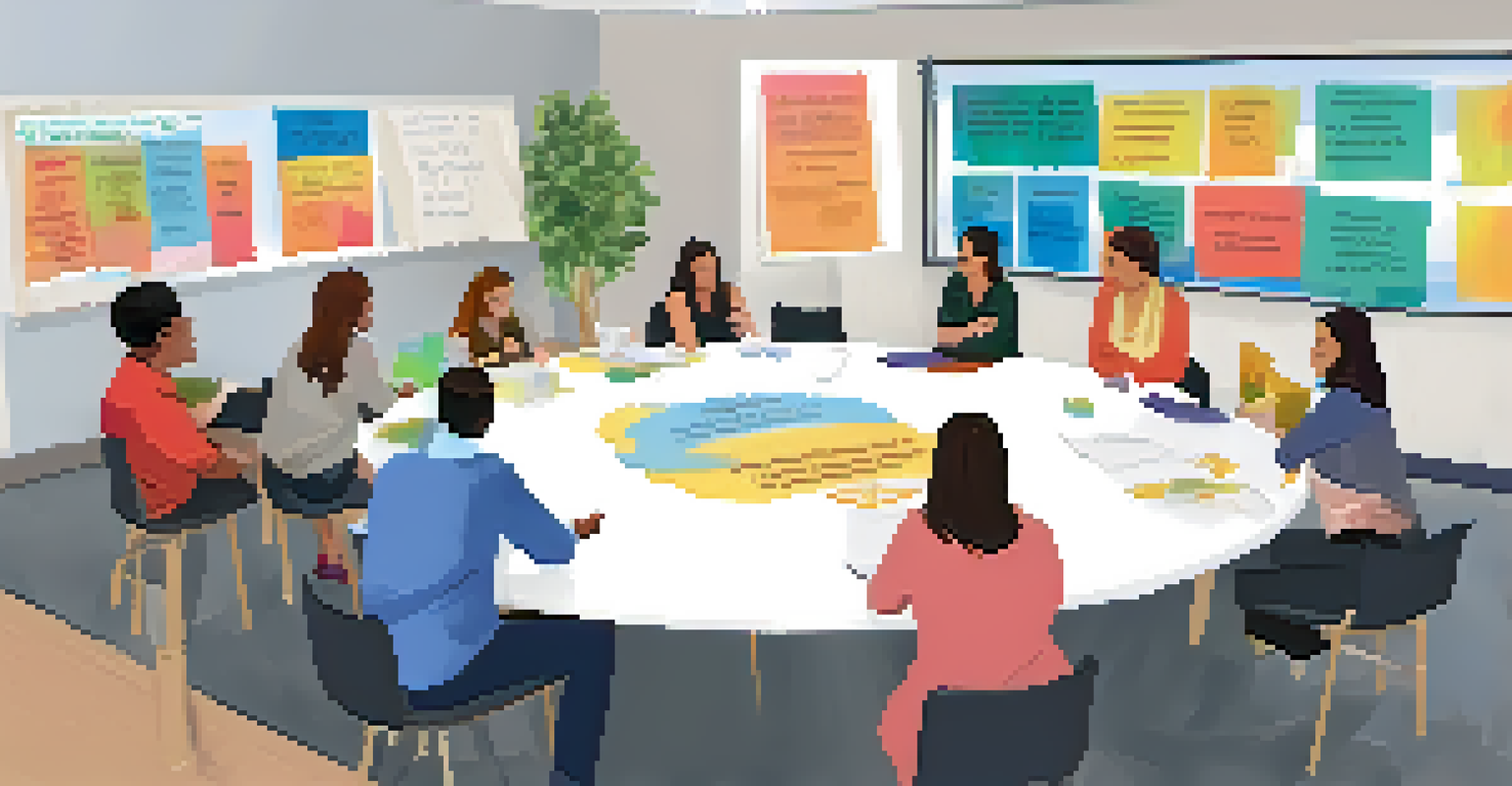Collaboration and Emotional Intelligence in Team Projects

Understanding Collaboration in Team Projects
Collaboration is the backbone of successful team projects. It involves working together towards a common goal, leveraging each member's unique skills and perspectives. When team members communicate openly and share their ideas, they create a dynamic environment that fosters innovation and creativity.
Alone, we can do so little; together, we can do so much.
Think of collaboration like a symphony orchestra, where each musician plays a distinct part yet works harmoniously to create beautiful music. In a team setting, collaboration ensures that everyone’s contributions are valued, leading to more effective problem-solving and decision-making. This collective effort often results in outcomes that surpass what individuals could achieve alone.
By cultivating a collaborative atmosphere, teams can enhance their overall performance. It encourages accountability and motivates team members to engage actively, leading to a more fulfilling work experience. Ultimately, collaboration not only drives project success but also strengthens interpersonal relationships within the team.
The Role of Emotional Intelligence in Teams
Emotional intelligence (EI) refers to the ability to recognize and manage our emotions and those of others. In the context of team projects, EI plays a crucial role in fostering a supportive and empathetic work environment. When team members possess high emotional intelligence, they are better equipped to navigate interpersonal dynamics and resolve conflicts effectively.

Imagine a team facing a tight deadline with varying stress levels among its members. A leader with strong emotional intelligence can recognize stress signals, validate feelings, and offer support, helping to maintain team morale. This not only enhances individual well-being but also contributes to team cohesion and productivity.
Collaboration Drives Team Success
Effective collaboration harnesses diverse skills and perspectives, leading to innovative solutions and enhanced project outcomes.
Furthermore, emotional intelligence encourages open communication, allowing team members to express concerns or ideas freely. By promoting a culture of empathy and understanding, teams can create an atmosphere where everyone feels safe to contribute, ultimately leading to more successful project outcomes.
Key Components of Emotional Intelligence
Emotional intelligence comprises several key components: self-awareness, self-regulation, motivation, empathy, and social skills. Self-awareness involves understanding one’s emotions, strengths, and weaknesses, which is essential for effective collaboration. When team members are self-aware, they can communicate their needs and boundaries clearly, fostering a respectful environment.
Emotional intelligence is the ability to make emotions work for you instead of against you.
Self-regulation allows individuals to manage their emotions and reactions, especially during challenging situations. For instance, when a project hits a snag, a team member with strong self-regulation can maintain composure and focus on solutions rather than dwelling on problems. This positive attitude can be contagious, uplifting the entire team’s spirit.
Empathy, perhaps one of the most critical components, enables team members to understand and relate to each other's feelings. By practicing empathy, teams can build trust and strengthen relationships, creating a foundation for collaboration. Ultimately, these emotional intelligence components work together to enhance team dynamics and drive project success.
The Benefits of Combining Collaboration and EI
When collaboration is paired with emotional intelligence, the results can be transformative. Teams that embrace both elements often experience improved communication, reduced conflict, and higher overall satisfaction. A collaborative environment enriched with emotional intelligence allows for a deeper understanding of team dynamics, leading to more effective collaboration.
For example, consider a marketing team brainstorming ideas for a new campaign. With strong collaboration and emotional intelligence, team members can share their thoughts openly without fear of judgment. This can lead to innovative ideas that might not have surfaced in a less supportive environment.
Emotional Intelligence Boosts Teams
High emotional intelligence fosters empathy and open communication, creating a supportive environment that improves team dynamics.
Moreover, the combination of collaboration and emotional intelligence can enhance resilience within a team. When challenges arise, emotionally intelligent team members can support each other, ensuring that the group remains focused and motivated. This resilience is key to navigating the ups and downs of team projects.
Strategies to Enhance Collaboration and EI in Teams
To foster collaboration and emotional intelligence in your team, start by creating an open communication culture. Encourage team members to share their thoughts and feelings regularly, whether through team meetings, feedback sessions, or informal check-ins. This openness helps everyone feel valued and understood, laying the groundwork for effective collaboration.
Another strategy is to invest in team-building activities that promote trust and camaraderie. These activities can range from workshops focused on emotional intelligence to fun group outings that strengthen relationships. The goal is to create shared experiences that enhance team cohesion and understanding.
Additionally, consider integrating emotional intelligence training into professional development. Providing resources and training can equip team members with the skills needed to navigate their emotions and those of others, further enhancing collaboration. By prioritizing these strategies, teams can create a thriving collaborative environment.
Real-World Examples of Successful Collaboration and EI
Many successful organizations exemplify the power of collaboration and emotional intelligence. For instance, companies like Google and Pixar prioritize open communication and team bonding, leading to innovative solutions and creative breakthroughs. Their success demonstrates how a collaborative environment combined with emotional intelligence can yield remarkable results.
In the healthcare sector, teams that embody collaboration and emotional intelligence often provide better patient care. For instance, interdisciplinary teams in hospitals work together, considering each member's expertise and emotional perspective. This holistic approach not only improves patient outcomes but also enhances team satisfaction.
Combine EI and Collaboration for Impact
The integration of emotional intelligence with collaboration enhances resilience and satisfaction, driving overall team performance.
These examples highlight that regardless of industry, the combination of collaboration and emotional intelligence can drive success. By observing and learning from these real-world applications, other teams can adopt similar practices to cultivate a thriving work environment.
Measuring the Impact of Collaboration and EI on Team Success
To understand how collaboration and emotional intelligence impact team success, it’s essential to establish measurable outcomes. This could involve tracking project completion rates, team satisfaction surveys, or qualitative feedback from team members. By assessing these metrics, leaders can gauge the effectiveness of their collaborative efforts and emotional intelligence initiatives.
Additionally, regular reflection sessions can provide insights into team dynamics. By discussing what worked well and what could be improved, teams can adapt and evolve their collaboration strategies. These reflections can foster a continuous improvement mindset, ensuring that teams remain agile and responsive to challenges.

Ultimately, measuring the impact of collaboration and emotional intelligence allows teams to celebrate successes and identify areas for growth. By prioritizing these evaluations, organizations can ensure that they are nurturing a collaborative and emotionally intelligent culture, leading to sustained success in team projects.